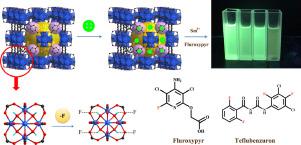Journal of the Taiwan Institute of Chemical Engineers ( IF 5.5 ) Pub Date : 2021-07-29 , DOI: 10.1016/j.jtice.2021.07.028 Liu Yang 1 , Yu-Long Liu 1 , Xian-Xian Ji 1 , Cheng-Guo Liu 2 , Ying Fu 1 , Fei Ye 1

|
Background
A novel luminescent sensor with dual-emitting platforms, Tb@UiO-66, was used for highly detecting Sm3+ and teflubenzuron.
Methods
Tb@UiO-66 was synthesized on basis of the exchange of guest molecules, where Tb3+ ions were encapsulated into the cages of UiO-66.
Significant finds
The results of multiband fluorescence originated from the linker-to-cluster charge transfer and the characteristic emission of TbIII. Tb@UiO-66 displayed luminescence enhancements or quenches according to small molecules. Especially for Sm3+ and teflubenzuron, the characteristic peaks of Tb@UiO-66 at 490, 545, 585, and 621 nm increased with the increasing of the concentration of the analytes, where Tb@UiO-66 exhibited the effect of luminescence enhancement. The detection limits for detecting Sm3+ and teflubenzuron were 0.09 μM and 0.21 μM, and the changes of luminescence intensities could be observed by naked eyes under the UV light at 365 nm. Tb@UiO-66 could also be used to detect teflubenzuron in real water samples. Tb@UiO-66 could be reused for at least 5 cycles for the detection of Sm3+ and teflubenzuron with the framework of Tb@UiO-66 uncollapsed. These results implied that the integration of LnIII luminescent materials and Zr-MOFs by doping method provided a new strategy for fabricating novel luminescent sensors for detecting polluting small molecules.
中文翻译:

基于Tb@UiO-66的新型发光传感器用于高度检测Sm3+和七氟苯脲
背景
一种具有双发射平台的新型发光传感器Tb@UiO-66用于高度检测 Sm 3+和七氟苯脲。
方法
Tb@UiO-66是在客体分子交换的基础上合成的,其中 Tb 3+离子被封装在UiO-66的笼子中。
重大发现
多波段荧光的结果源于连接子到簇的电荷转移和 Tb III的特征发射。Tb@UiO-66根据小分子显示发光增强或淬灭。特别是对于 Sm 3+和七氟苯脲,Tb@UiO-66在490、545、585和 621 nm的特征峰随着分析物浓度的增加而增加,其中Tb@UiO-66表现出发光增强的作用. 检测Sm 3+和七氟苯脲的检出限分别为0.09 μM和0.21 μM,在365 nm紫外光下用肉眼可以观察到发光强度的变化。Tb@UiO-66也可用于检测实际水样中的七氟苯脲。Tb@UiO-66可以重复使用至少 5 个循环,用于检测 Sm 3+和 teflubenzuron,而Tb@UiO-66的框架未折叠。这些结果表明,通过掺杂方法将 Ln III发光材料和 Zr-MOFs集成为制造用于检测污染小分子的新型发光传感器提供了新策略。









































 京公网安备 11010802027423号
京公网安备 11010802027423号